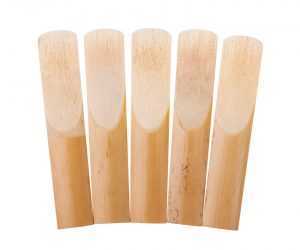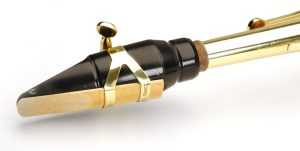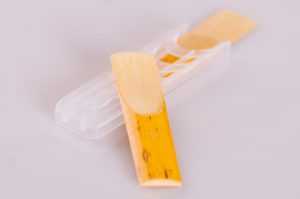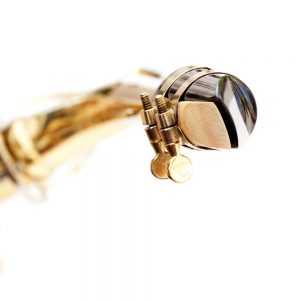If you have ever struggled with a difficult reed, then I’m sure you understand how crucial reeds are when playing the saxophone, and how the slightest variations in reed strength can make a huge difference. If you’ve ever found yourself using too much energy, blowing a ton of air, while hearing or feeling a bunch of that air escaping out the sides of the mouthpiece, then your reed is probably too hard. If you’ve ever found yourself having trouble trying to pinch out high notes, while producing a very thin sound, and squeaking frequently, then your reed is probably too soft. The goal is to find the healthy medium; a reed that minimizes limitations and that gets the least in the way of playing the saxophone.

Although reeds are relatively inexpensive, they are an extremely important part of playing the saxophone, and picking the type of reed and correct reed strength that works for you is essential to feeling comfortable when playing and to sounding the best that you can.
Choosing the right reed strength can be a complicated process. Let’s ponder a couple of scenarios. Maybe you can relate.
- Your band director or private teacher gave you a couple of sample reeds to try out. You really liked one or both of them initially, but now they feel and sound too thin. You bought a new reed of the same brand and strength, but now it feels too stiff.
- You have yet to find a reed that feels comfortable for you. You’re overwhelmed with the huge variety of both types and strengths of reeds. You can’t afford to buy a bunch of different types to try out and you can’t afford to buy a box of ten reeds, only to find out you don’t like them.
There are a couple of effective strategies to fix the issue in the first scenario. There are short-term options, if you need a reed to perform well immediately, and there are long-term strategies, which are ultimately more effective. If you need a soft reed to play better, you can try pushing the reed up on the mouthpiece, so that the reed extends slightly past the tip of the mouthpiece. This will make the reed feel a little thicker. Conversely, if you need a hard reed to play better, you can lower the reed on the mouthpiece so part of the tip of the mouthpiece is visible. You can also move the tip of the reed side to side, if one side of the reed is thicker or thinner than the other. With a thicker reed, you can also shave it down using sandpaper or a reed knife. Some people prefer to do this, so that they have a personalized reed. This takes practice, though.
are ultimately more effective. If you need a soft reed to play better, you can try pushing the reed up on the mouthpiece, so that the reed extends slightly past the tip of the mouthpiece. This will make the reed feel a little thicker. Conversely, if you need a hard reed to play better, you can lower the reed on the mouthpiece so part of the tip of the mouthpiece is visible. You can also move the tip of the reed side to side, if one side of the reed is thicker or thinner than the other. With a thicker reed, you can also shave it down using sandpaper or a reed knife. Some people prefer to do this, so that they have a personalized reed. This takes practice, though.
There are long-term strategies that work better in the long run to extend a reed’s life. Of course, reeds deteriorate over time; they don’t last forever. Every reed will get progressively softer and softer the more you play it. All you can do is try to make this process as slow as possible. You want to try to extend the reed’s lifespan to its maximum. A couple methods for doing this include a process of breaking in reeds (playing for a little bit each day to not shock the reed, to prevent water-logging) and rotating reeds (using a few reeds at a time, so you’re not overplaying one reed).
We’ll go over the second scenario in this article, as it pertains specifically to the content.
Choosing Your Reed Strength
Musicians who don’t play reed instruments probably put very little thought into how complicated reeds are. They might think there’s just one generic type of reeds. Not true, obviously. There are many different types of reeds, and many things to consider when determining the correct reed for you. It is definitely a process.
 Reeds can be constructed from different materials: most reeds are made from cane, although there are reeds that are made from synthetic materials (plastic) as well as reeds that are a hybrid of cane and synthetic. Reeds are made for different styles: there are reeds that are advertised as classical reeds, reeds that are advertised as jazz reeds, etc. There are different brands of reeds: Vandoren, La Voz, Rico, etc. In addition, there are filed and there are unfiled reeds, just in case things weren’t complicated enough already.
Reeds can be constructed from different materials: most reeds are made from cane, although there are reeds that are made from synthetic materials (plastic) as well as reeds that are a hybrid of cane and synthetic. Reeds are made for different styles: there are reeds that are advertised as classical reeds, reeds that are advertised as jazz reeds, etc. There are different brands of reeds: Vandoren, La Voz, Rico, etc. In addition, there are filed and there are unfiled reeds, just in case things weren’t complicated enough already.
Once you have all of that figured out, reeds also come in different strengths. Most reeds use a number system from 1 to 5, with increments of 0.5, although La Voz uses S, MS, M, MH, H. Reed strength isn’t universal between brands and a size 3 of one brand or style is not the exact same as a size 3 of another brand or style. Choosing the reed strength that works for you is more or less trial and error. Everyone’s oral cavity is built differently, so the mouthpiece and reed combination you use is highly individual. Some people use a mouthpiece with a wide tip opening in combination with a softer reed, while some people use a mouthpiece with a narrow tip opening in combination with a harder reed. Some people like to buy size 5 reeds and alter each reed to be perfect for them.
You can ask your band director or private teacher if they have any reeds you can sample. Your band director may have some extras on hand. If your private teacher is endorsed by any reed company, they get free trial reeds, and probably don’t use all of them. In addition, some companies sell reed sample packs that have a few different styles of reeds in them.
Recommended Reed Strength for Beginners
Finding the right reed strength for each saxophone player is a process, and highly individual, but there are some common reed types and strengths that are time-tested and proven to work well for beginners. Most beginners start by using La Voz or Rico reeds, because they are the cheapest brands. A size 2 reed is a great place to start for a beginner. Play on it for a while before switching to a 2.5, unless it feels entirely too soft, then 2.5 is okay. Size 3 is definitely too hard for a beginner though. Once again, it depends on the specific reed, though. A 1.5 may be okay if a 2 feels too hard. On La Voz, MS to M is a good place to start. These are just some basic guidelines of where to start. If you have a private teacher, he or she should be involved in the process of picking a good reed, and letting you know if it works for you.
When to Change the Strength of Your Reed
It’s easy to get used to something and to resist change, but change is ultimately beneficial. If you’ve been playing a reed strength that you’ve been very happy with, it’s hard to admit that it’s time to move up or down in strength. But, sometimes it’s necessary. Most likely you will be moving up. If you start on a 2, you will eventually move up to a 2.5, probably followed a 3, and then maybe a 3.5. Once again, this should all be consulted with your private teacher if you have one. You may have to move down in reed strength as well. You may realize that you’ve moved up in strengths too quickly, and find that taking a step back to a softer reed is a good move. It’s also possible that you got a new mouthpiece with a wider tip opening, and the reed strength you’ve been playing is now too hard in combination. Just remember, there will be an adjustment period when changing reed strengths, but it will be worth it in the long-term.

Conclusion
The ultimate goal, when it comes to reeds, is finding the reed that makes you forget completely about reeds. You want to find a reed that gets in the way the least, that is the least limiting. You already have to deal with choosing a good horn and picking the best mouthpiece and ligature combination that works for you. Picking out the reed strength that works for you is a process, but once you have it figured out, you won’t need to think about it anymore (at least for a while), and you’ll sound the best that you can. Getting into the habit of breaking in reeds and rotating reeds can make you worry even less about reeds. Reeds, after all, can be one of the most stressful parts of playing the saxophone. But, at least be grateful you don’t play oboe. This would be a much lengthier article if you did. Good luck.







